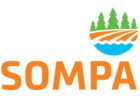Transforming drained peatsoils to paludiculture would help mitigating greenhouse gas emissions and contribute to the EU 2050 carbon neutrality agenda. Synergy effects with water and biodiversity protection and novel business opportunities are key advantages of paludiculture in comparison to many other peatland use methods.
The climate impact of cultivated peatlands is significant as they are 2.5% of the total agricultural area but produce almost 25% of the total agricultural GHG emissions in the EU (EU annual GHG report 2019, 740). The urgency of climate mitigation action is widely acknowledged, most significantly through the IPCC reporting and it appears on political agendas in EU. Yet, the substantial socio-economic importance related to cultivated drained peatlands makes changing peatland management a highly political issue that reaches beyond climate policy.
Sabine Wichmann from the Greifswald Mire Center travelled via land and sea to Helsinki to minimize her own carbon footprint, and to explain why rewetting of drained peatlands and paludiculture (i.e. peatland cultivation with water tables near surface) as climate smart peatland use would help reach the climate neutrality targets by 2050 in EU and by 2035 in Finland.
New research including different peatland utilization scenarios identifies “prompt rewetting of all drained peatlands” as best option to limit long-term climate warming effects. Sabine highlights and argues that it is better to go for wet peatlands emitting methane, which is short-lasting and therefore less harmful, than to continue draining peatlands and emitting large amounts of CO2 from the decomposition of peat, which accumulates in the atmosphere.
“prompt rewetting of all drained peatlands” is the best option to limit long-term climate warming effects.
However, the transformation to paludiculture is costly to the single farmer and calls for economic incentives – “similar to the high societal support which was provided for draining and reclaiming peatlands”, Sabine reminds. Marketable products and high demand for e.g. cattail and Sphagnum moss biomass products exist but there are not enough producers. Paludiculture needs to be acknowledged as agriculture and eligible for CAP direct payments (Pillar I). A set of different incentives (Pillar II, rural development) is needed to acknowledge and make use of its potential in contributing to 2050 carbon neutrality goal. CAP reform can be a window of opportunity for sustainable peatland management.
transformation to paludiculture calls for economic incentives – “similar to the high societal support which was provided for draining and reclaiming peatlands”
Sabine Wichmann was an invited lecturer in a seminar in Viikki. The seminar concluded that the Nordic and Baltic Sea regions can map their way towards carbon neutrality in land use sector by establishing sustainable peatland use practices and supportive policy instruments. Road-mapping process was started in the seminar.
